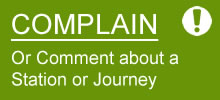Author: Dennis Fancett
1. Introduction
The great British experiment with rail franchising is finally over. In an announcement from
the UK government on 20th May 2021, we were told that franchises will be replaced by private companies operating under service contracts to specifications and fare levels set by government through a new national rail contracts body which will be part of a new institution “Great British Railways” - the wording almost but not quite a return to the “British Rail” that existed before Prime Minister John Major first privatised the railways in 1994.
2. So What Went Wrong?
The UK government, of course, claims nothing. To overtly admit the privatisation policy of a previous Conservative government had failed would be politically unacceptable. The communication is therefore more nuanced, using phrases such as “franchising has served its time”, “private operators will continue to play a major part”, and “we will continue to grow the network”, suggesting an enhancement or development of policy rather than a U-turn.
But to those in the industry, either players or stakeholder groups, there is recognition that franchising failed on two major fronts. Firstly, government inability to prevent over-bidding resulting in the financial failure of operators mid-franchise (which has happened three times in succession on the East Coast Main line route), and secondly, woefully inadequate service performance for example from the hapless Northern operator - taken back into public ownership shortly after the timetable change debacle of May 2018. To be fair, there was a strong case for saying those particular service difficulties were not Northern’s fault - promised infrastructure improvements were not delivered and no-one raised the alarm in time. But it has been politically easier to blame the system than Network Rail (essentially another arm of government) and noteworthy that Northern’s owners Arriva, themselves part of the German Deutsche Bahn, did not publicly kick up a fuss, perhaps quietly relieved to be rid of their problem child.
3. The New Model
The service contracts for rail which will now be introduced will be similar to those run by Transport for London for overground, underground and busses in the nation’s capital. Private operators will bid to run rail routes, but service levels and fares will be set by a new national contracts body.
The significance is that the majority of responsibility for innovation, risk and reward will remain with the government body. Whilst private operators will continue to run trains, and earn a management fee for doing so, they will not be expected to “bet against the economy” (ie accurately predict economic growth and the resultant rise or fall in passenger numbers) in preparing their bids, which in turn become easier and less expensive to prepare, adjudicate and manage. They will only have very limited freedom to vary routes or service levels; these issues will be fixed by the tender set by the national rail contracts body that the bidder will offer a price for delivering.
In London, all the busses are painted red. All display the Transport for London symbol. All accept Oyster and Travel cards 1. They all charge the same fare for the same journey 2. But they are operated by a variety of different companies, (several of whom are train operators too), but the travelling passenger wouldn’t notice this without looking quite carefully at the small print on the timetable or on the bus itself to spot which company is the operator. The fact the drivers are working for different companies under different terms and conditions is of little concern to the travelling passenger.
Despite the blaze of publicity, the new system for trains had been widely predicted. With the continuation of the franchising system effectively ruled out, and full renationalisation unacceptable to the Conservative government on political grounds, there wasn’t really anywhere else to go. COVID has in fact made the step much simpler. The new system is not significantly different from what has been operating for the past year under the government’s Emergency Measures Agreement. Last week’s announcement sets out the legal framework to make the new arrangements permanent and to establish the public bodies that will be necessary to run them.
So what impact if any can the new arrangements be expected to have in various different areas?
4. Fares
Under the old system, rail companies were allowed to increase fares each year by a maximum of “RPI + “X”%, RPI being a measure of inflation and “X” being an additional amount set by the government. In reality, the government was simply setting the level of increase, since no company ever chose not to take up the full increase possible. Calls on the government to use the lower measure of inflation - CPI - claimed by government to be a fairer measure in instances where it was paying out money such as pensions, had gone unheeded.
Under the new system, presumably, the government will simply set the level of fare increases, so no real change here.
The lasting impact of COVID is more likely to have an impact on levels of fare increases. Less commuting (from more working at home) could mean less political pressure on government to keep increases to acceptable levels, and it may find itself tempted to increase farebox revenue especially when passenger numbers have fallen.
However, only standard walk-on and season ticket fares were regulated. The individual rail franchisees had discretion to set their own level of discounted advance purchase fares, and this is where the bargains on the railways were to be had. Whether the government will have the same skill at understanding the price elasticity of its product and responding to it, remains to be seen.
Some silly anomalies arising from journeys comprising segments with more than one operator, giving rise to the “split ticketing” phenomena, because operators would only add another operator’s segment to their standard fare, and not to their discounted fare, will hopefully disappear in our brave, new integrated world. Faster development of smartcard technology is also promised, and better integration with other types of public transport is hinted at and can be expected, though most likely only bus metro and tram - the combined flight plus rail tickets increasingly seen in Europe still seem a long way from government thinking.
5. Integration
With the exception of a small number of fare anomalies referred to above, the previous system was already pretty integrated, with all operators required to sell each other’s tickets and give the customer the best option (even if on another operator’s service) and there has not been any significant evidence to suggest this didn’t happen. So there is little to improve here, other than the fact the new system should be much easier to understand, with the specific train operator no longer being relevant in the eyes of the traveller.
We might hope for better integration of the timetable on segments of lines where different routes overlap, for instance York to Edinburgh, where all 3 operators seem to want to do the same thing (run non-stop) and no-one willing to offer a reasonable service to the intermediate and local stations in between. This is hinted at by the reference to the fact the new GBR will have an overall strategic role, but this could simply be code for a central government desire to throw local and semi-fast operators off main-line routes to make room for more non-stop services between London and regional cities. The proof of the pudding will be whether the English regions and devolved administrations for Scotland and Wales will be given enough power to challenge the London-centric thinking, and whether these regional bodies will likewise fall into the trap of just wanting to connect their own bigger cities to London, or give sufficient priority to connecting their rural hinterlands to the regional towns and cities that serve them.
We might also hope for better integration in times of disruption, with much quicker decisions on the acceptance of one operator’s tickets by other service providers, and significant administrative savings from the current blame attribution and penalties game following complex incidents. Customer information should also improve in the long term, though current issues where a station operated by one company doesn’t know about what is happening to another company’s trains is more due to disintegrated communications systems than any intended desire to be unhelpful. The real headache in terms of disruption management is East Coast operator LNER’s move to compulsory seat reservations, which makes flexibility when things go wrong well-nigh impossible, especially if other long-distance operators follow suit. We can only hope that GBR will think again on this, but with LNER having conceived the idea whilst already being directly government owned, this doesn’t seem too likely at present.
6. Investment
Investment can be split into new rolling stock and track improvements. For rolling stock, whilst the previous system appeared to give the decision to the privatised operator, issues such as the requirement to eliminate non disability compliant stock, increase the number of available units and to enhance on-board services such as wifi often gave a bidder no option than to specify new stock for all or part of its fleet. Plus, with franchise lengths becoming shorter and government often needing to underwrite major rolling stock purchasing decisions, then inherited by the next franchisee, it is perhaps cleaner and clearer all round for decisions to simply be taken by government directly.
A few weeks ago, we might have had high expectations that the new arrangements could in the long term deliver greater standardisation of fleets, achieving economies of a scale from the same units being used on all lines across the network with common route characteristics. But the recent sad circumstances of all Hitachi’s Class 800 units needing to be removed from service for urgent safety checks, virtually closing two of our main routes out of London and causing considerable difficulty for a 3rd regional operator has brought into sharp focus whether fleet standardisation is indeed a good thing or not.
For network enhancements and re-openings, the key issue will be whether the new strategic body inherits Network Rail’s aversion to and inflated costs for small scale locally sponsored schemes which do not form part of the core strategic routes radiating out of London.
7. A Greener Railway?
Nothing in the new arrangements as published so far will either accelerate or hinder the development of a greener railway, although a plan for decarbonisation is to be produced in 2022. There are however two related issues worth keeping an eye on: Firstly, that Network Rail’s staggeringly high costs of electrification are leading the government more towards battery technology and hybrid trains as the way to eliminate diesel, and secondly, the imperative to “go green” is at present more likely to come from powerful regional city mayors, who, once they have successfully banned petrol cars from city centres, will surely next want to turn their attention to diesel trains.
8. Innovation
A criticism of the former British Rail is that its central, bureaucratic command and control structure stunted local innovation, and the franchising model giving power to local managers has reversed this. However, that assumption is a matter of opinion. The pre-privatisation re-organisation of British Rail into Intercity, Network South-East and Regional Railways and the establishment of CrossCountry as a route increased power to local BR managers, whereas on the other hand, even after privatisation, no matter how innovative local managers were, genuine operational improvements still had to be pushed through and agreed with Network Rail. The flexibility to innovate also depends on how congested the network is and there can be no doubt that the huge increase in passengers and number of trains being run have and will continue to make the system much more congested than it was when originally privatised, though whether concurrent improvements in signalling technologies - giving the ability to push more trains down the track than previously - should have been more than adequate to support this growth is difficult to evaluate.
Nevertheless, a concern is that under the new arrangements, local managers will not have the financial authority to make a service variation, no matter how clear it might be that increased fares revenue will outweigh costs. It will all need to be put back to, and agreed by the contracts authority who won’t have the local knowledge or be dealing with the local stakeholders. Again, this will be time for the English regions and devolved administrations of Scotland and Wales to make their voices heard, the concern being the devolved administrations are somewhat ahead of the game here than the English regions.
9. Open Access
The levels of congestion on the UK’s rail network have never permitted the development of a multiplicity of open access operators serving a range of routes and destinations excluded from franchise specifications. They have however been successful in identifying a few cities with limited rail connections to London but without a major technical reason why such a service can not be provided. Currently open access operators serve Hull, Bradford and Sunderland 3 with a 4th route to Newcastle, Morpeth and Edinburgh starting later this year. Failed operations have included Wrexham and Blackpool.
A concern would be open access operators may now be squeezed off the network. On the other hand, with the private operators fulfilling the service contracts no longer taking the risk of farebox revenue raids, they would have little reason to object to new proposals. It will essentially become a government versus government debate, and only time will tell which arm of government, or political mantra within government, will win.
10. Freight
Again, there is no detail so far suggesting either positive or negative developments for rail freight. It is however noteworthy that under the current system, rail campaigners who wish to push through a re-opening or route upgrade which can not be totally justified on passenger requirements alone, but offers significant benefits for freight operations, have no mechanism for the passenger and freight advantages to be considered together. We hope the strategic function of the new GBR will be able to do this more easily in future.
11. UK plc
An unintended consequence of the previous privatised franchising model is that UK train operators came close to extinction from the UK market with more and more franchisees being awarded to foreign companies either still owned by or retaining close links to their national government. A longstanding joke, especially amongst proponents of a return to nationalisation, was that UK trains were indeed run by the government - just not the UK government. Again, opinions as to why this happened would vary, with suspicions of foreign companies being financially supported by their national governments never proven.
With regard to train building, the situation is complex, again with opinions varying as to whether lower costs of foreign built train units are better in the long-run than short term gain of UK jobs, and the advantage of British made versus UK-based factories or assembly plants of foreign owned companies difficult to evaluate. The reality is that Brexit is more likely to have an impact on how the train building industry develops in the UK than Williams-Shapps.
12. Catering and Panache
Many critics of the former nationalised network point to the example of the boring British Rail sandwich to show what was wrong with nationalisation. This is hardly fair, and indeed, if that was all that was wrong, with no more complex infrastructural issues to resolve, then privatisation of the system has been a huge sledgehammer to crack a very tiny nut. In truth, expectations of catering have risen sharply across society as a whole in the years since British Rail was privatised, with sandwich and coffee making now considered an artisan profession. Even national airline carrier BA has recognised this, and abandoned its own in-house offering for the ability to purchase from popular branded luxury retailer “M&S Simply Food” on its short-haul flights. So we should not compare the 1980s sandwich offering from BR- an era where Costa and Starbucks had not even been heard of, with the 2020 market expectations.
But panache - the romance of rail travel, including luxury items such as the ability of first-class passengers to dine on board, and even dare we suggest the sleeper train - should not be overlooked, especially at a time when the industry must turn once again to leisure travellers and those opting for rail for the journey experience to make up the shortfall in commuter revenue.
We might hope now for a consistent level of catering and first-class service across the network. Currently, on some routes, catering is complementary in first class, but this is not universal. It may or may not be on a china plate, and may be freshly cooked or an unappetising microwave offering. In truth though, operators are restrained by the rolling stock they are using and the existence and size of on-board kitchens. So there will only be limited scope for change in the short term.
13. Non-Operational Costs
But if there is one area in which the new system must score hands down over the flawed franchising model it is replacing, it is that the huge costs of bidding for franchises, adjudicating 4 them and then monitoring compliance, which will now be removed from the system. There will be less speculative cost of failed bids for operators to recoup from the contracts they do win. It should also become easier for smaller, potentially more efficient operators to enter the market, driving down costs in the longer term. Reference has already been made to the administrative and legal costs of the complex behind the scenes delay attribution process which should now also be removed from the system. On these criteria alone the new arrangements should be welcomed, but campaigners must remain vigilant, judging the new arrangements solely by their outcomes and not by any political dogma or nostalgic desire to return to a previous model.
End
Dennis Fancett is a member of Railfuture’s European Passenger Group and its delegate to the European Passenger Federation, Committee Member and Press Spokesman for Railfuture North East Branch, and Chair of SENRUG, a local rail campaign group affiliated to Railfuture, but the opinions expressed in this article are his own and do not necessarily reflect the opinion of either Railfuture or SENRUG.
For the UK government’s White Paper itself see https://www.gov.uk/government/publications/great-british-railways-williams-shapps-plan-for-rail and for Railfuture’s official and informed analysis of it go to http://www.railfuture.org.uk/article1882-Great-British-Railways
Notes
1. Except sightseeing busses aimed at the visitor market and charging premium fares.
2. Although the writer believes that TfL’s failure to understand that long-distance, limited stop, pay as you board coaches can justify a premium fare and did not need to have the same fare structure as regular busses led to the failure and subsequent demise of London’s “Green Line” network. Similarities apply where local stopping trains run on the same routes as faster limited-stop trains.
3. Technically, Heathrow Express is an open-access operator too.
4. In 2012, the UK government was threatened with court action for incorrectly awarding the West Coast Main Line franchise to First Group. It was obliged to reverse its decision, re-award the franchise to Stagecoach-Virgin, and compensate First Group. See https://www.bbc.co.uk/news/uk-19402133
Back to More...








